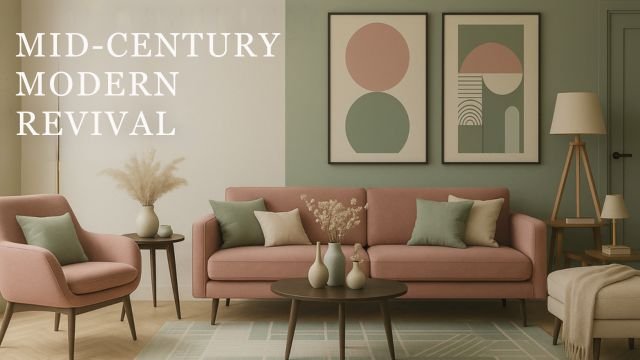Some styles quietly fade into memory. Others come roaring back into relevance with the kind of clarity that feels both nostalgic and entirely new. Mid‑Century Modern is firmly in the second camp. It has woven its way back into our homes, not as a trend but as a beloved standard. And the living room in the image you shared captures it perfectly. It’s confident without shouting, functional without being cold, and playful without a single misplaced detail.
So what exactly makes this room such a pitch-perfect expression of Mid‑Century Modern design? The answer lies in the way it blends color, shape, and simplicity with intentional balance. At first glance, it’s warm and inviting. A second look reveals layers of thoughtful design decisions, all rooted in mid‑century ideals but interpreted with a very present-day sensibility.
The Colour Confidence That Defines It
Mid‑Century Modern interiors are known for their bold, intelligent use of color. This room leans into that heritage beautifully. Saturated mustard, deep teal, and burnt orange create a palette that is both grounded and optimistic. These aren’t just accent shades. They speak. They harmonize with the natural sunlight that spills across the herringbone floor and bounce gently off the neutral walls.
Teal has depth, almost like still water. Mustard brings energy without aggression. Burnt orange, nestled into cushions and artwork, adds an earthy warmth that stabilizes the whole palette. The result is a space that feels emotionally grounded yet mentally alert. These colours don’t just match the furniture. They match the mood we crave from our homes right now: relaxed, hopeful, grounded.
Furniture That Floats, Not Overwhelms
In Mid‑Century Modern design, furniture is part sculpture, part utility. Everything here serves a purpose, but nothing feels purely practical. The low-profile mustard sofa has a clear lineage to the postwar boom in American design, when living rooms started to become lighter and more open. Clean lines, exposed legs, and a lack of bulky arms create a feeling of visual space. It invites conversation and interaction instead of imposing on the room.
The armchair speaks the same visual language: tapered legs, minimal curves, and bold color. Even the coffee table, a simple round shape with a matte black finish, anchors the room without demanding attention. It’s a supporting actor, not a lead, and that’s exactly what Mid‑Century Modern gets right about composition. It’s about balance. No ego, just elegance.
Then comes the arc lamp. That iconic curve stretching over the seating area is the room’s subtle drama. It adds lift and flow, curving above the hard geometry of chairs and tables. Its golden finish reflects both light and style. There’s just one lamp like it in the room, and there doesn’t need to be another. It’s a statement that finishes the sentence.
Geometry in Art and Floor
Mid‑Century Modern design was always connected to geometry, often inspired by the Bauhaus school’s philosophy: function in form, harmony in shape. The wall art here does exactly that. Simple circles, half-moons, lines, and rectangles framed in black show how less can be far more. They’re not just decorative. They echo the rug’s bold geometry and reinforce the visual rhythm of the room.
Speaking of rugs, look down. That area rug is a masterstroke. Its grid and repeating patterns mirror the shapes above and below. In doing so, it becomes the third element in a quiet trio: the art, the rug, and the furnishings. Each speaks the same geometric dialect. That kind of cohesion is not just stylish, it’s deeply satisfying.
Texture That Warms Without Fuss
While the lines are clean and the geometry is tight, the room never feels sterile. This is where Mid‑Century Modern shows its soul. Dried pampas grass in muted vases adds a soft, feathery contrast to the crisp visuals. Throws draped casually over the sofa promise comfort. A mix of fabrics—velvet, boucle, cotton—makes the room feel tactile. There is warmth in the air, not just in the colours.
The herringbone wood floor helps, of course. It’s timeless. But when paired with modern furniture, it gets a fresh edge. That’s the beauty of Mid‑Century Modern. It respects history, but it doesn’t live in it. It evolves.
Why This Design Still Works in 2025
There’s a reason this look has stuck around. Mid‑Century Modern is adaptable. It can be bright or muted, minimal or eclectic, vintage or brand new. The principles—clean lines, human-centered functionality, colour with purpose—are just as relevant now as they were seventy years ago.
We want homes that reflect our values, not just our tastes. We want beauty, but we want it to feel real. Not overly decorated. Not artificial. The Mid‑Century Modern living room you see here is stylish, yes. But it’s also a room you can live in. Lounge in. Spill coffee in. Let the sunlight in. The design supports the lifestyle, not the other way around.
In a world that’s getting louder and faster, this kind of grounded simplicity feels like a breath of air. And that’s what keeps Mid‑Century Modern from becoming just another trend. It’s not a throwback. It’s a timeless, evolving foundation for how we shape the spaces we call home.


